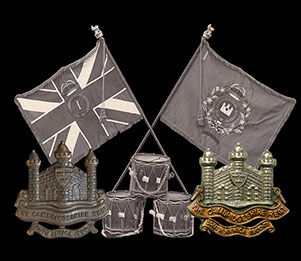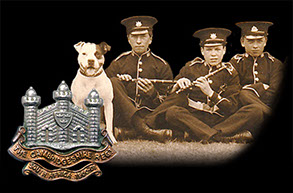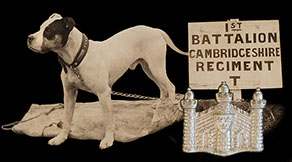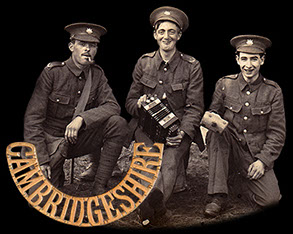
The Cambs
at War
Who Were
The Cambs
1/1st Btn 1914-1919
1914 - 1/1st Overview
1915 - 1/1st Overview
1915 - St Eloi
1915 - Fosse Wood
1916 - 1/1st Overview
1916 - The Schwaben
1916 - St Pierre Divion
1917 - 1/1st Overview
1917 - St Julien
Insignia, Medals & Books
Remembering The Cambs
Biographies
About Us &
This Site
Fig A - 1914 Location, Recruitment Areas and Drill Stations for the Companies (Coys) of the 1st Battalion, The Cambridgeshire Regiment TF.
Coy Drill Hall Drill Stations
HQ Cambridge
A Coy Cambridge Great Shelford &
Burwell
B Coy Cambridge Sawston
C Coy Cambridge Madingley
D Coy Cambridge
E Coy Wisbech
F Coy Whittlesey Coates & Thorney
G Coy March Chatteris, Benwick
& Doddington
H Coy Ely Sutton
Fig B - Annual Camp locations and dates for the Cambs TF.
1908 - Great Yarmouth, July.
1909 - Felixstowe, July.
1910 - Bixley Heath Camp, Ipswich, July
- Aug.
1911 - Thetford, July.
1912 - Offington Park, Worthing, July
- Aug.
1913 - Shorncliffe Camp, between Hythe
& Sandgate, July - Aug (also Diss,
July).
1914 - Ashridge Park, Berkhampstead,
July - Aug.
Click the link below for a detailed study of Cambs service numbers and how to work out enlistment dates from them.

The London Gazette announcement.

The Regiment's new Colours and Drums.

Young D Coy musicians and mascot.

Cambs mascot at the 1911 Thetford camp.

A group of G Coy men at camp.

Cambs TF friends at camp.
1st Battalion, The Cambridgeshire Regiment TF 1908 - August 1914
Organisation
The 1st Cambs, like the 3rd VB before it, was made up of companies (Coys) spread out across the county with the Headquarters at Cambridge (see Fig A for Coy locations). The Cambridge Drill Hall on Corn Exchange Street was the location for the Battalion HQ, Coys A, B, C and D were also based there, each having a different night for their weekly parade and training. The rest of the Coys were spread out across the Fenland and Isle of Ely with drill halls at Ely, Wisbech, Whittlesey, and March. Smaller Drill Stations were located through out each Coys recruiting area in villages where there was a concentration of volunteers (see Fig A).
Each Coy when at full strength comprised of three officers and one hundred and seventeen other ranks, split into a Company HQ and two platoons. The officers were normally a Captain or Major as the Company Commander and two Lieutenants or 2nd Lieutenants as the Platoon Commanders. The platoons were further split into four sections of men under a NCO.
As well as the four standard infantry Coys there was also the Battalion HQ. This was made up of the Commanding Officer (CO), the Adjutant (a Regular Army officer attached to the Regiment for administration purposes), the Regimental Sergeant Major (RSM), the Quartermaster (QM) and his staff, along with the Signal Section, Transport Section, Stretcher Bearers and various other support elements. Various other specialist trades were needed to keep the battalion running smoothly, many of these came from amongst the volunteers such as cobblers and saddlers. However roles such as Medical Officer were filled by an officer on attachment from the TF element of the Royal Army Medical Corps.
Another important element in the pre-war battalion was the Machine Gun Section. This was equipped with two Maxim machine guns and was made up of an officer and seventeen other ranks. As a further part of the pre-war battalion's exploration into "modern" methods of warfare there were also experiments with Cyclist Sections and motorised transport.
Although the Battalion got its own separate identity from the Suffolk Regiment in 1909, the link between the two regiments remained strong. The Suffolk Regiment provided all permanent staff instructors for the newly formed Cambs Regiment. These instructors played a vital role in both the training and administration of each Coy. An attached Suffolk Regiment warrant officer also filled the position of Regimental Sergeant Major.
The Pre-War Years
1908
The 3rd (Cambridgeshire) Volunteer Battalion, The Suffolk Regiment laid up its Colours on the 19th March 1908 at Great St. Mary's Church in Cambridge. Two days later on the 31st March at a service on the Market Square in Cambridge the new TF Battalion came into being. Approximately half of the old VB men transferred over and signed up with the new Battalion giving it an initial strength of 345 men. By the Battalion's first annual camp in July the strength was 394. This figure comprised of 16 officers, the Adjutant and 7 permanent staff instructors, and 357 other ranks.
The Battalion strength was a cause for great concern amongst many as the number of men that transferred over had been much lower than hoped. Also the men who had been in the old VB had been given the option of signing up for only one year instead of the usual four. The hesitation to volunteer is understandable though, the TF was a new organisation with many untried elements involved and many wanted to see if it would work before committing. The situation was improved in November and support was more forthcoming after a meeting was held in Cambridge with Lord Haldane himself as the guest speaker. Events such as this also helped to encourage the employers and local businesses to support the TF and permit their staff to join.
1909
It was announced in the 12th March 1909 London Gazette that the Cambridgeshire Regiment had come into being. This was a great moral boost for all those connected to it and the new "County Regiment" also brought about an increase in recruits. On the 19th July at Windsor, during a review of the newly formed TF, the King presented new Colours to the Regiment. Annual camp for 1909 was held in a rather rainy July at Felixstowe. The public events and forming of the new Regiment all helped to bring the strength up and by the end of the year the Battalion was just short of 900.
1910
The start of 1910 saw the Cambs and the TF concept further accepted by both employers and workers with a steady stream of new recruits joining during the recruiting weeks. The Battalion was involved in various memorial events around the county in May marking the death of King Edward VII. In late July and early August the annual camp for the year was held at Bixley Heath, near Ipswich. It was split into a Regimental camp for the first week and then for the second week the whole of the East Midlands Brigade (of which the Cambs was part of) was present.
1911
On 13th March 1911 the Honorary Colonel of the Regiment, Lord French, visited the Cambs and various parades and events were held in his honour. May saw a big change for the Regiment when the original Commanding Officer, Col. Lyon, retired. He was replaced by Col. L. Tebbutt. This change in CO also brought about a change and a more modern approach to training. Numerous events were attended around the county in June to mark the coronation of King George V. That summer the annual camp was held at Thetford for two weeks in July.
1912
1912 was a fairly quiet year for the Cambs. As in previous years there were numerous shooting competitions and events, both at a county and a national level. The prize money always served as a good incentive and competition was fierce, the experienced old VB men often did very well. The annual camp for the year was held at Offington Park, Worthing. Recruiting and re-enlistment soon became a key topic, it was recognised that some 60% of the Cambs men were due to come to the end of their four years service in 1913. These were the men of the old VB and the men who were the backbone of the Regiment. Many of them would be likely to sign up for another term but there were no guarantees and it was accepted that there would be a drop in strength.
1913
As predicted there was a drop in the Battalion's strength in 1913. This was lessened by a high take up of men signing up for a further four years as well as reasonably successful recruiting. However the Cambs were still some 300 men short of being at full strength. Some Coys were struggling to recruit more than others, with G Coy at March being by far the most in need of new men. At the other end of the scale D Coy with its large amount of volunteers from the Pitts Press workforce was nearly at full strength. The attendance figures at that year's annual camp remained high, it was held on the south coast again this time at Shorncliffe Camp near Hythe.
1914
1914 started for the Cambs with a massive recruiting drive during the January recruiting week. This recruiting push came about as the threats of war in Europe were growing and the national media was paying a great deal of attention to the arguments for and against conscription in the UK. The recruiting week was a great success for the Cambs and a new wave of recruits helped replenish the numbers and made up for the drop in previous years. Many of these new recruits were 17 and in some cases even younger (having modified their dates of birth or joined as drummers and buglers).
By the time of the annual camp the Battalion was impressively at full strength. The two week camp for 1914 was in late July and held at Ashridge Park. All the men and officers were well aware of the goings on elsewhere in Europe and the subject of possible war was a common topic of conversation. The threat of war became even more apparent to the men when on the 27th July the War Office declared the "First Precautionary Period", meaning the armed force were to prepare for imminent war. The men returned home from camp on Sunday 2nd August. Just two days later at 11pm on the 4th August 1914 Britain declared war on Germany. Orders were immediately sent out mobilising the TF and calling for the men to report to their Drill Halls. The Cambs were going to war.

This site went live on the 14th February 2015 to mark 100 years since the 1/1st Cambs went off to war.
WE WILL REMEMBER THEM
Email us: cambsregt@gmail.com
Copyright 2015, 2016, 2017, 2018, 2019 by Felix Jackson. The information and images on this site should not be reproduced without prior permission.